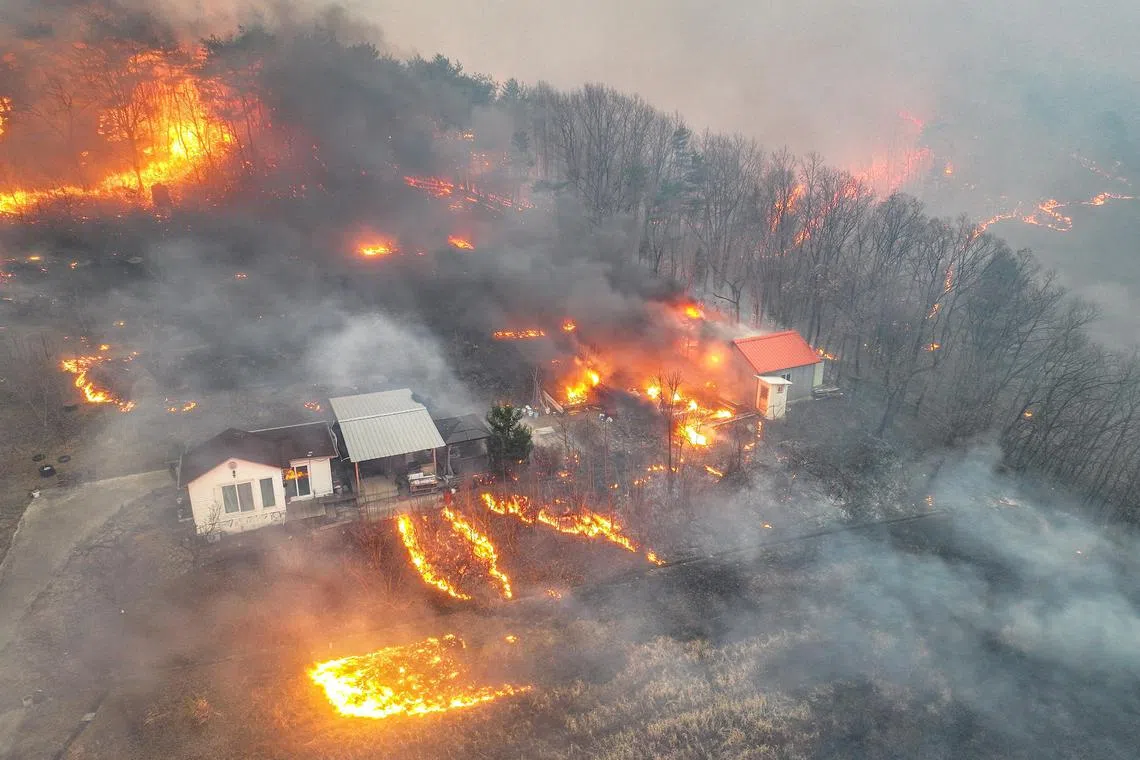South Korea struggles to contain deadly wildfires
Sign up now: Get insights on Asia's fast-moving developments

The wildfires have so far affected approximately 14,694ha, with damage continuing to grow.
PHOTO: REUTERS
Follow topic:
UISEONG, South Korea - Deadly wildfires in South Korea worsened overnight, officials said on March 25, as dry, windy weather hampered efforts to contain one of the country’s worst fire outbreaks.
More than a dozen blazes broke out over the weekend, with the safety minister reporting thousands of hectares burnt and four people killed
“The wildfires have so far affected approximately 14,694ha, with damage continuing to grow,” Acting Interior and Safety Minister Ko Ki-dong said.
The extent of damage would make the fires collectively the third largest in South Korea’s history. The largest was an April 2000 blaze that scorched 23,913ha across the east coast.
More than 3,000 people have been evacuated to shelters, Mr Ko said. At least 11 people have been seriously injured.
“Strong winds, dry weather and haze are hampering firefighting efforts,” Mr Ko told a disaster and safety meeting.
The government is “mobilising all available resources”, he said.
The government declared a state of emergency in four regions, citing “the extensive damage caused by simultaneous wildfires”, and thousands of people have been ordered to evacuate.
Late on March 25, the authorities in Andong issued an emergency alert to residents of the historic Hahoe Folk Village – a Unesco-listed world heritage site popular with tourists – as the blaze drew closer.
“The Uiseong Angye wildfire is moving in the direction” of the area, the alert said. “Residents are requested to evacuate immediately.”
In Uiseong county, the sky was full of smoke and haze, with the Korea Forest Service saying the containment rate for the fire in that area had decreased from 60 to 55 per cent on March 25.
Early in the morning, workers at the Gounsa Temple, which is more than 1,000 years old, were attempting to move valuable artefacts and cover up Buddhist statues to protect them from possible damage.
“We used fire-retardant blankets,” Mr Joo Jung-wan, a Gyeongbuk Seobu Cultural Heritage Care Center worker, told AFP, saying that a giant gilded Buddha statue was too large to be moved, so it had been carefully covered.
Hours later, an official at the Korea Heritage Service told AFP that the temple had been burned down. “It is very heartbreaking and painful to see the precious temples that are over a thousand years old being lost,” monk Deung-woon said.
Family grave
More than 6,700 firefighters have been deployed to battle the wildfires, according to the Ministry of Interior and Safety, with nearly two-fifths dispatched to Uiseong.
Some types of extreme weather have a well-established link with climate change, such as heatwaves or heavy rainfall.
Other phenomena, such as forest fires, droughts, snowstorms and tropical storms, can result from a combination of complex factors.
In Daegu city and the North Gyeongsang region, “the air is extremely dry and strong winds are blowing, creating the risk that even a small spark could quickly spread into a large wildfire”, an official from the local meteorological administration said.
The fire in Uiseong was reportedly caused by an individual visiting a family grave. According to local media, the person told emergency services: “I accidentally started the fire while cleaning the grave site.”
South Korea’s Acting President confirmed this was most likely the case.
“The wildfire is believed to have been caused by an individual who was visiting an ancestral grave and accidentally started the blaze,” Prime Minister Han Duck-soo said during a Cabinet meeting on March 25.
“Most wildfires are caused by human negligence and the public should strictly follow wildfire prevention guidelines,” he added.
Neighbouring Japan is also experiencing wildfires, with hundreds of firefighters battling a blaze in Imabari city of western Ehime prefecture since March 23. Another wildfire, which also started on March 23, affected the city of Okayama, burning around 250ha and damaging six buildings.
Japan saw its worst wildfire

